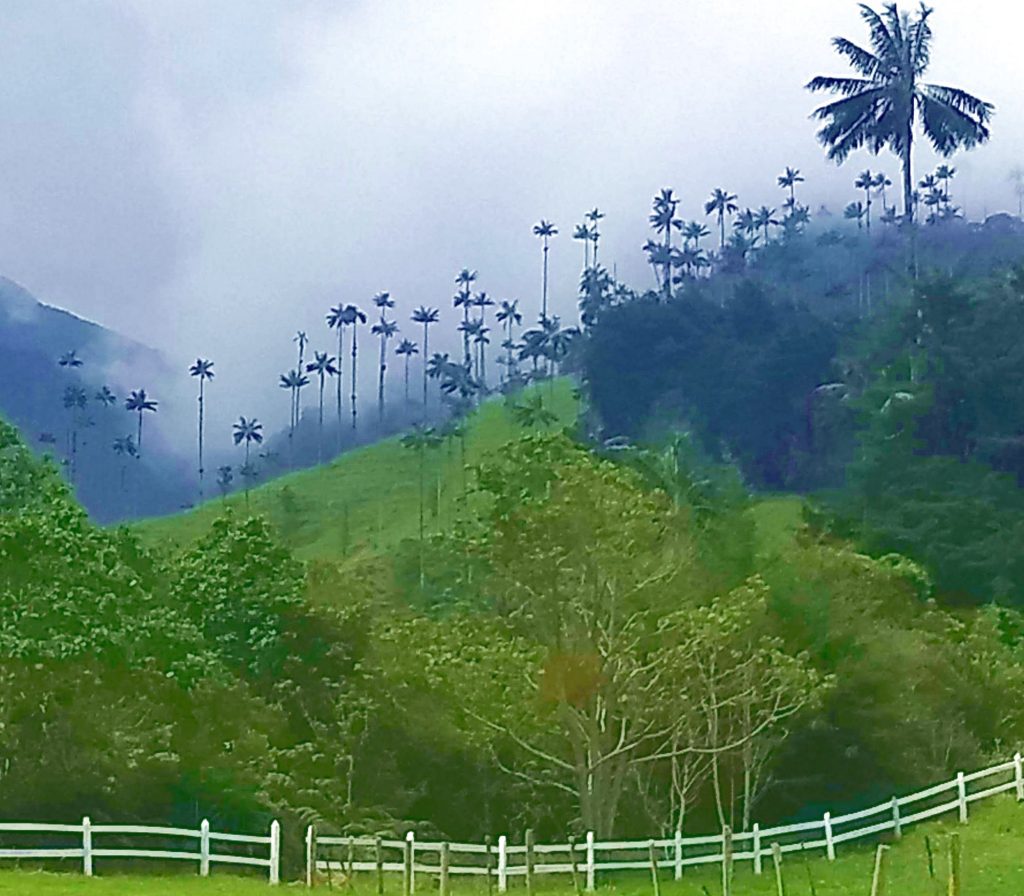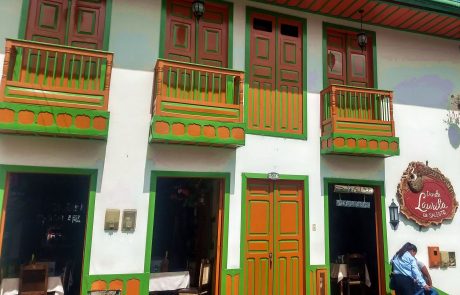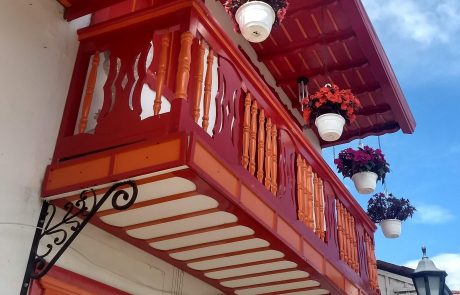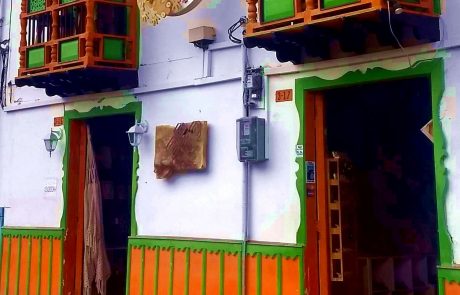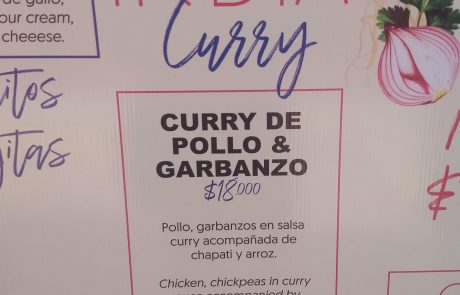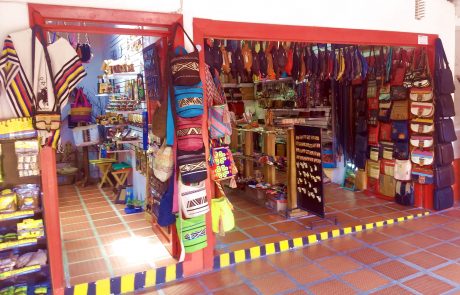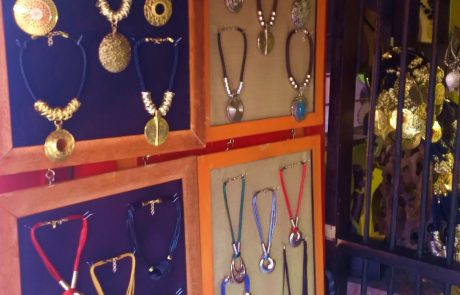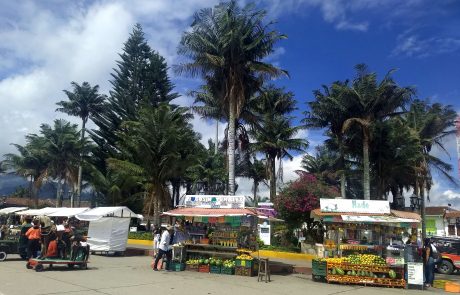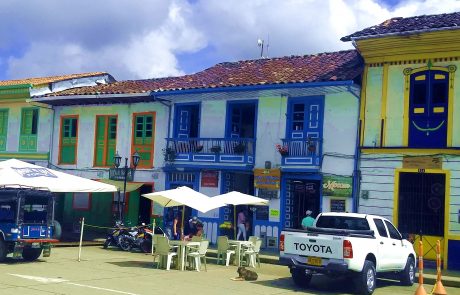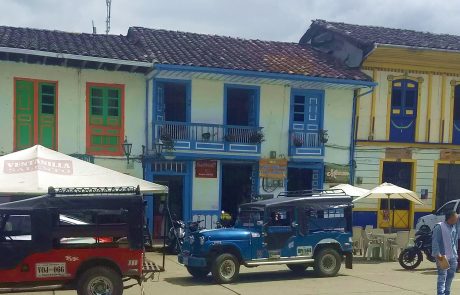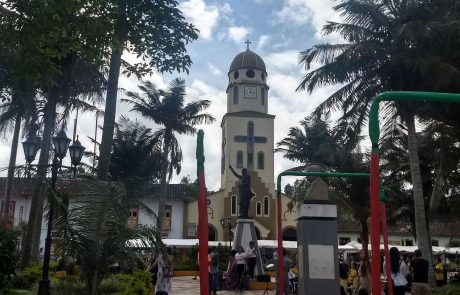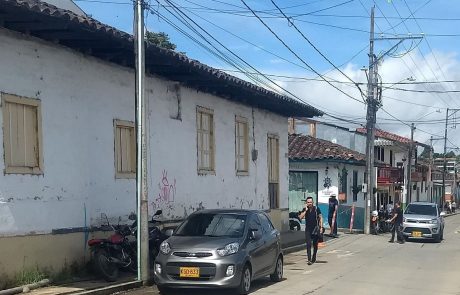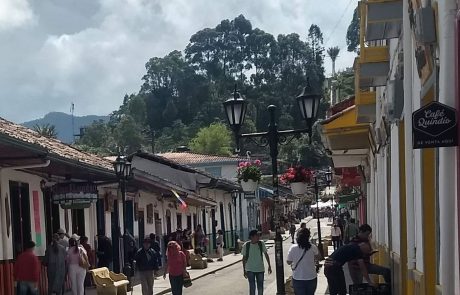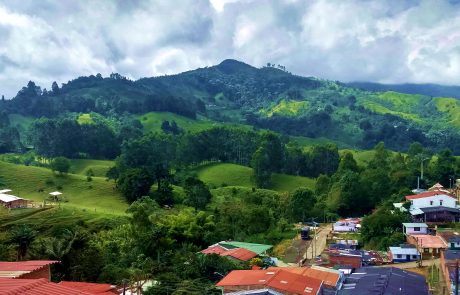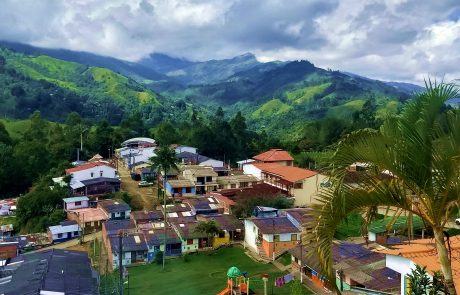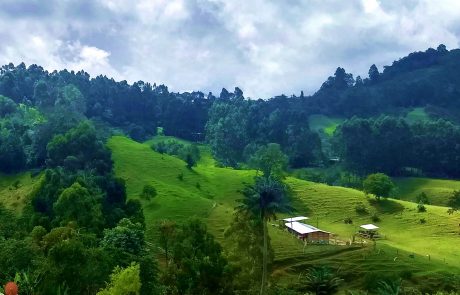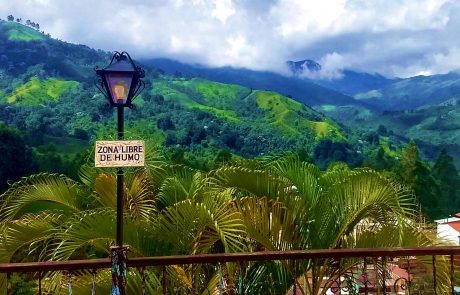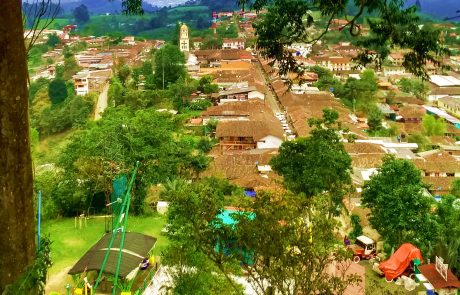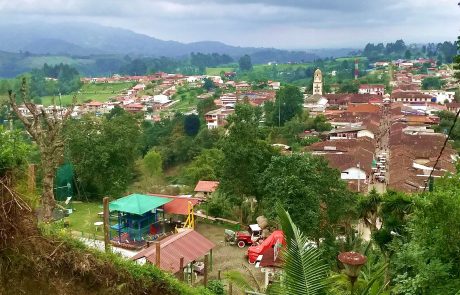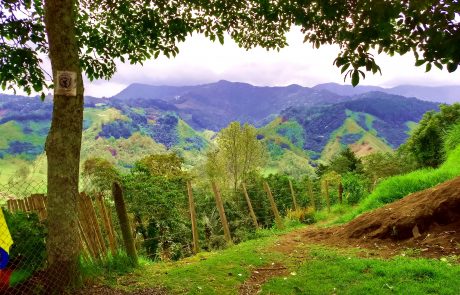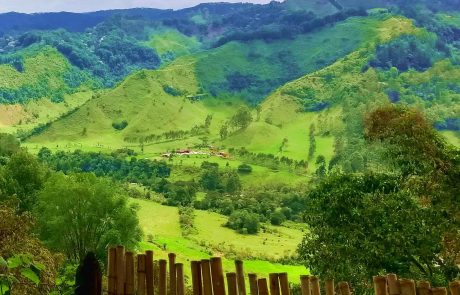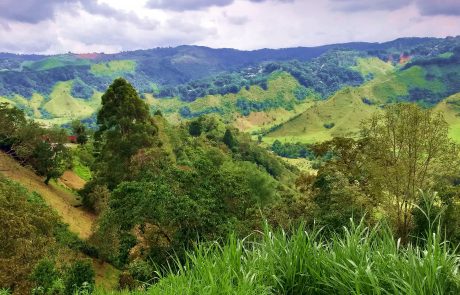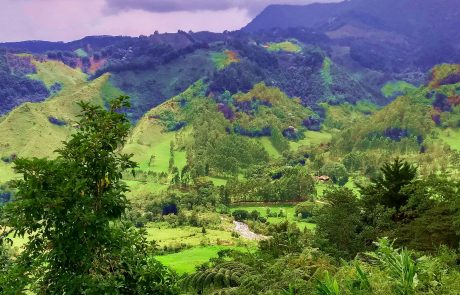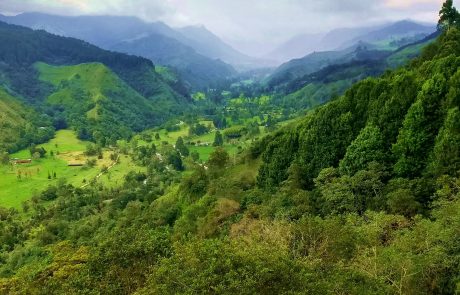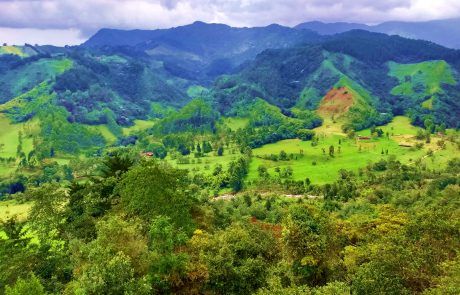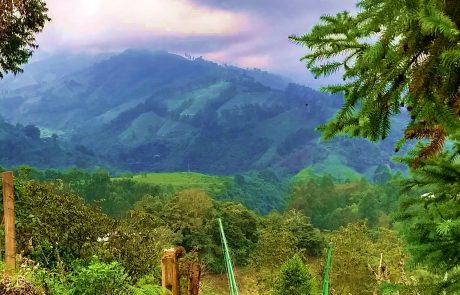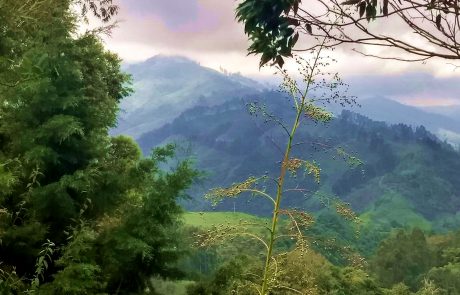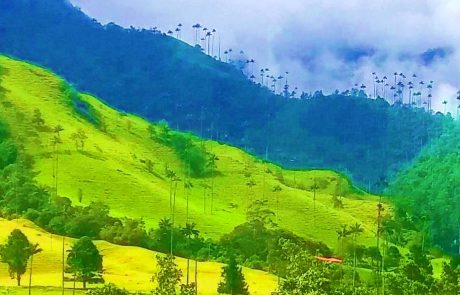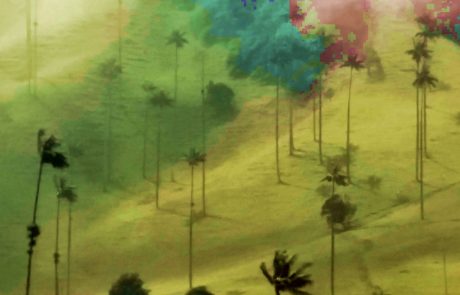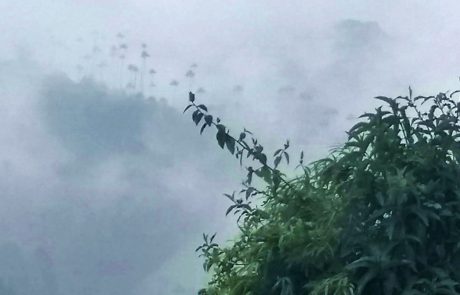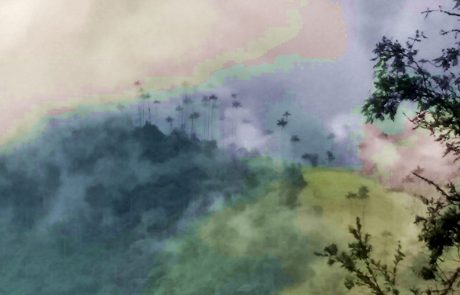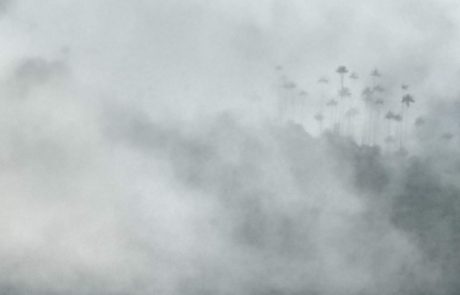July 2019
 If you were given the task of picking the most famous tourist spot of the Coffee Triangle, the choice would likely fall on Salento and the Valle de Cocora. I’ve read information on the Internet that claims it’s one of the top tourist spots (for Colombians) in the entire country. Obviously you can get loads of info on the web and pictures of the wax palms in the Valle de Cocora are a dime a dozen in Google Images, so you may well wonder what point there is in having Yours Truly go over ground so thoroughly travelled already. Well, I’ve found my market niche as a reporter on Salento. I’m giving you the Aesthetics Tour. 🙂 Was that a smile or a grimace I saw flit across your face?
If you were given the task of picking the most famous tourist spot of the Coffee Triangle, the choice would likely fall on Salento and the Valle de Cocora. I’ve read information on the Internet that claims it’s one of the top tourist spots (for Colombians) in the entire country. Obviously you can get loads of info on the web and pictures of the wax palms in the Valle de Cocora are a dime a dozen in Google Images, so you may well wonder what point there is in having Yours Truly go over ground so thoroughly travelled already. Well, I’ve found my market niche as a reporter on Salento. I’m giving you the Aesthetics Tour. 🙂 Was that a smile or a grimace I saw flit across your face?
Continuing in the vein I opened in an earlier post about just being after the pretty stuff, I’m going to comment on the aesthetics of the place rather than load you up with tourist info on where to get the best burger. You can get that stuff from plenty of other folks, in English even, woohoo! I went to Salento and the Valle after a month of gathering experiences in other places in the Triangle. That experiential offset brought me to consider the place from the standpoint of comparison. Such a perspective has something useful to contribute to the discussion, so here we go.

This map gives you the general layout of the town. It’s a typical town with the typical structure we’ve seen already in Filandia and Marsella. The main plaza has the church and the two-storey buildings forming the other arms of the square. As far as historical significance goes, Salento has more in its past than other towns and considerably less to show for it than places like Filandia or Marsella. More skinny on that from the Wikipedia page (here):
In the colonial era, the main route from Popayán to Bogotá traveled over the Quindío Pass (a.k.a. “La Línea”), passing through the modern-day site of Salento. In 1830 Simón Bolívar traveled the route and ordered that it be upgraded due to its poor condition and strategic importance. However, the town was not established until 5 January 1842, after the Guerra de los Supremos. Political prisoners from that war were sent from Panamá, Antioquia and Cauca to upgrade and maintain the road. After completing their sentences they were given a plot of land in the region.
The site of the penal colony was known as Barcinales, located where Salento is today. However, the main settlement was in the valley in Boquía, where the Boquía stream joins the Quindío river. Families of the prisoners arrived and built their houses in Boquía and established farms upstream in the Cocora valley.
Sometime around 1854 a flood of the Quindío river destroyed the settlement of Boquía, and the survivors rebuilt their houses in Barcinales. They retained the name Boquía for the new settlement, changing the name of the original settlement to Pueblo Viejo.
In 1864 a census of the new Boquía showed that it had 581 inhabitants. The occupational breakdown comprised 148 farmers, 2 carpenters, 1 blacksmith, 11 doctors, 1 lawyer, 2 tailors, 4 laborers, 11 merchants and 11 watchmakers.
In 1865 Boquía was officially declared a municipality and its name was changed again to Villa de Nueva Salento, and the name of Boquía reverted to the original settlement in the valley. The new name of the municipality was given in honor of Salento, a region in the south of Italy.
Marsella in Risaralda Department is named after Marseilles, France. What an internationally aspirational lot these colonizing paisas were. Whoda thunkit?
A little further on in the article we come across this chestnut, which confirms what I said above:
The town is one of the major tourist attractions of Colombia, thanks to its peaceful nature (although it fills up with tourists at weekends and on bank holidays), impressive scenery, easy access to the Cocora valley, and the retention of much of its original bahareque architecture typical of the eje cafetero region. This style of architecture is especially notable on Carrera 6, a.k.a. Calle Real (English: Royal Road), the road that leads north-east from the town square to a mirador (look-out point), the Alto de la Cruz. The road is the major thoroughfare of Salento and contains many shops, mainly selling locally-made handcrafts.
There, you see — you don’t need me to tell you what’s what in Salento, Wikipedia has beat me to the punch. But ah, the aesthetics … what about the aesthetics? That’s a different matter altogether.
Despite Salento’s longer history compared with other towns of the Eje Cafetero it has relatively little to show in the way of unified town architecture. There are some impressive balconies, on that account there is no doubt, but the town doesn’t provide the experience of an historical town in the manner that Marsella or Filandia delivers it. It has its architecture zoned in the town square area and the commercial streets just off the square. In that sense, it doesn’t feel organically historic like Marsella. It feels like a tourist town staged for the purpose of making money. That doesn’t detract from the handsomeness of the architectural details on offer, but it hardly contributes to a sense of history coming alive before your very eyes. Let’s start with some pics of the architectural details on the main commercial street:
Let’s not mince words here: Salento is about shopping. If you think I’m exaggerating, take a look at these pics from the main street, which is lined with shops selling all kinds of stuff, some of it obviously high end:
The menu item pic is from one of the (toney) restaurants on the commercial street. I was astonished by it because Salento is the last place I’d expect to see chapatis with a chicken curry advertised. I’m not sure how many Colombians even know what a chapati is, but hey, it’s available in Salento. I didn’t eat at the restaurant so I can’t vouch for the authenticity. And after you enjoy your Indian cuisine you can sidle on over to the jewelry shop and pick out a bauble for your pleasure. It’s gonna set you back a bit, however, so make sure your credit card isn’t near the red zone or you’ll go into a blush when the “transaction denied” message prints out on the little slip.
This all goes to show that Salento is about selling stuff to visitors, which is what a proper tourist venue should do. I have nothing against tourist venues since I’m a tourist myself, but the hype on the Internet is about Salento being traditional. I don’t think that’s the case any longer. It looks too much like tourist venues anywhere else in the world for that to be convincing. The balconies are lovely, true, but they’re just part of the tourist shtick and they’re supposed to limber up your visual apparatus to look at stuff to buy. All well and good, tourist shops have their place in creation, as well. Let me not cavil about tourists and shopping since I’d be the pot calling the kettle black.
The town square is predictable in its arrangement but quite enjoyable in its reality. It’s a fairly large one and there’s a lot going on there. When I approached it the first time there was a band (of the high school variety) playing Queen’s “We Will Rock You.” Forget vallenato, forget salsa, forget cumbia, it’s Queen for wind band arrangement in the Salento town square, babes. And they will rock you, oh yes they will. As is always the case, there’s plenty of fresh fruit action going on. There’s also an elderly couple dancing salsa with pretty wild moves for you to watch. You show appreciation by dropping some pesos in the hat by the side of the show. I watched and paid but I thought to myself, “What a way to make a living …” You do what you gotta do, I suppose. Fortunately I’m spared public exhibition of my lack of talent for dancing.
So, to the pics, with a view of all the sides, the church as well as the buildings on the other three sides of the quadrangle:
If you’re wondering why everything’s on a tilt, it’s because I was on a tilt. I neglected to compensate for the incline. :-). These amateur photographers, really …
It’s all very well and good to have a splashy town square but the real story gets told when you hit the sidestreets where people actually live. And that story is kind of ho-hum if the truth be told:
Like I said, not too different from the backstreets of Pereira, except the buildings are higher in Pereira, usually two stories, not one. They’re similarly nondescript in their appearance, however. This is architecture just to get the basic job done, no fancy stuff.
I’m beginning to sound like a broken record but the reality stands so let me spill the beans: I went for the landscape. You’re probably thinking, OMG the landscape again, jeez meknees. You’ll just have to give a tourist a break. I looked at the fancy jewelry and oohed and aahed. I had designer coffee in a quaint cafe. I watched the aged salsa dancers in the town square. I ate a traditional lunch in a restaurant (and while eating it came up with about six ways to improve it). I ticked all the tourist boxes, thank you very much. But yes, I went for the landscape. So sue me.
The landscape is inseparable from the charm of Salento. It’s a powerful additive to places like Marsella and Manizales, but it’s the major flava in Salento. My job now as Aesthetic Purveyor is to convince you that the town, despite its many charms, is but an appendage to the spectacular landscape in which it nestles. The aesthetics come from the landscape. The wax palms that render Salento a tourist destination in the first place have everything to do with the landscape (not with aged salsa dancers or spendy jewelry), and were it not for the landscape Salento would be some flyblown little town off the main highway that nobody bothers about. So let us tarry no longer with the things of man and have a look at what the Planet is up to in the environs, shall we?
Pics first, taken from within the town at various locations. Then we’ll head out of town toward the Valle de Cocora for a look at some rural landscapes. They’re gonna knock your socks off.
If you give me a choice between landscapes like those above and the opportunity to watch two people in their 60’s dance salsa in a town square, what do you think I’m gonna pick? Duuh. The landscapes. These are nothing out of the ordinary, by the way, just run-of-the-mill views you get as you move through the various offerings of Salento. The pics taken from a high perspective are from the hill on which the town’s viewpoint (mirador) sits. It affords a view over the lower end of the Cocora Valley as well as over the town of Salento. All the other perspectives come from within the boundaries of the town itself.
Imagine, if you will, Salento plopped down in Kansas with nothing but waving wheat for hundreds of miles in every direction. Then ask yourself this question: are the cute balconies enough to make Salento a hotshot tourist spot? My jury is still out on that one. Deliberations continue under sequestration.
By the way the sign in the fourth pic says “This Is A Smoke-Free Zone.” If that doesn’t tell you that Salento has arrived as a major tourist destination, I don’t know what does. If you’re gonna be in the big leagues you have to treat puffers as scum of the earth. It’s all part of the gig. I was tempted to light up and claim ignorance as a dumb foreigner but my momma raised me right so I abstained. More karma stars …
After you’ve exhausted the possibilities of Salento as a point of interest you inevitably head out to the Valle de Cocora to see the wax palms. It’s the done thing dontcha know. There are jeeps departing regularly for the tourist center at the entrance to the palm area of the valley. I didn’t check the prices because I was with friends who have a car, so I remained blissfully, nay ecstatically immune to the rigors of public transportation. Looking at the folks crammed onto two skinny benches in the back of a jeep, packed in like sardines, I thanked my lucky stars that I was being conveyed thither with the whole back seat of a new Renault Logan to myself. That’s when you know you’re luck’s at the top of its game. Yes siree.
The journey through the valley toward the palm area is enchantment itself. The Quindio River runs through it — it’s hard to believe that so puny a river could do much in the way of valley making, but hey, truth is stranger than fiction so I’m willing to buy the story. Really, though, the river would qualify at best as a stream in the USA. Or a creek, if you’re a hick from the sticks like me. “River” seems rather too generous a term, but again, as a foreigner mine is not to question why so I’ll just say “river” and zip it. If you live near some major waterway in the States — the Rio Grande, the Mississippi, etc. etc. — adjust your attitude before arrival and you’re golden.
I don’t need to comment on the landscape pics, Nature does all the talking that’s needed. So here you go:
OK kids, we’ve now reached the main aesthetic point of our little tour so I’m going to start laying it on thick. As for the tourist center at the entrance to the Valle de Cocora’s wax palm area, all I can say is that it’s just that — a tourist center — and in spades. After the entrance point there are two options for getting to the main viewing areas — on foot or on horseback. My friends inquired about the prices of the horseback option as I stood blithely aside. No fiber of my being twitched in surprise when I saw them draw back in horror after hearing the cost. If you’ve shelled out for Disneyworld or the likes in the USA it’s a pittance, but for the average Colombian it’s what you’d spend on a small wedding. It’s been over 20 years since I was on horseback and my lumbar region was not keen on a reunion with its checkered past, so I urged my friends to drop the idea of the horses and walk. That lucky charm from Filandia was at work again — I rubbed it between my palms for a good five minutes before I left for the trip and OH BOY did it pay off. 🙂
It’s time now to talk about weather — not in the English manner where it becomes pro forma, but rather as a living element of the life of the Planet. The Andes collect all sorts of weather sticking up into the sky as they do, catching clouds coming from the Pacific Ocean. Their weather is changeable to the point it makes London skies seem fairly predictable by comparison. During my day in Salento and Cocora the weather went from sunny to overcast to rain to “sunbreaks” (a word Oregonians from the coast area invented and fobbed off on the rest of us LOL), to being enveloped in drifting clouds when we were in the Valle de Cocora. This is Business As Usual. You don’t wake up in the Coffee Triangle, see the sunshine and say to yourself, “Oh good, today’s a sunny day.” It might be a sunny morning but who knows what looms ahead in the afternoon. You could be up to your ankles in runoff from heavy rain before you get to dinnertime.
Photographs are static things and capture a single moment. Weather is entirely the opposite. As your Aesthetic Reporter it became clear to me as I sat in a cafe at the Cocora Valley tourist center that this time Nature would have to play the winning hand. So instead of a series of perfect pictures of wax palms holding forth magnificently in their natural habitat, I present to you a dance between two elements, sky and mountains. It’s a slow dance, like a sarabande from the 18th century. You watch the changes for the sake of the change itself rather than to see an end result. It’s what I call “Zen watching.” That’s what we’re gonna do with our photos of the palms, since the ones taken on sunny days with perfect visibility are as common as houseflies at a 4th of July picnic. So stop making sense and just absorb the image with the realization that it’s one single gesture in a dance with something before it and something after it that the picture itself might reveal to you if you allow its Zen to work on you.
There’s a lovely cafe at the tourist area that sits up top one of the buildings. It was quiet and I sat there with my cappuccino while the rain fell. By the time I finished my cup of mojo the rain had stopped and the sun was out. I felt I could sit there all afternoon and with the passage of every quarter hour I’d have a different experience of the landscape around me. That’s what I call magic: the new from the old without end, amen.
No, I didn’t hike into the valley to see the main palm area. I didn’t feel the need to do so and things were wet, so my $5 WalMart shoes weren’t up to the task. But I’ll go back and do the hike and see the larger stands of wax palms sitting on their mountain perches. They’re astonishing apparitions in the landscape. You could go back four, five times, even more, and not tire of seeing them. I can easily imagine spending a lifetime around them as the residents of the Valley do. They’re one of Nature’s exclamation points in a field of superlatives. Small wonder it’s hard to get enough of them. I’ll have to go back for more, that’s a duuh moment if ever there was one.
